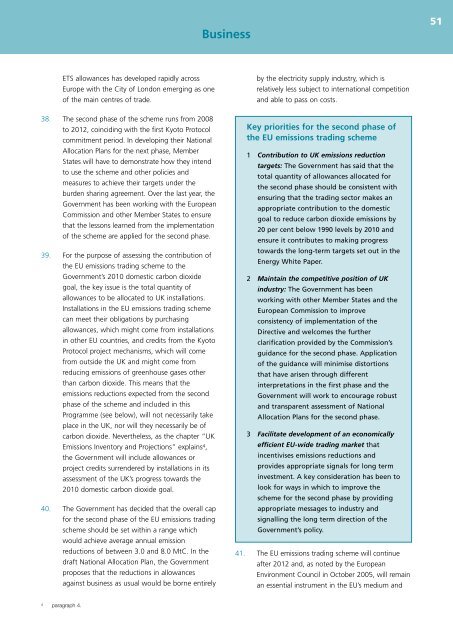UK Climate Change Programme 2006 - JNCC - Defra
UK Climate Change Programme 2006 - JNCC - Defra
UK Climate Change Programme 2006 - JNCC - Defra
Create successful ePaper yourself
Turn your PDF publications into a flip-book with our unique Google optimized e-Paper software.
Business<br />
51<br />
ETS allowances has developed rapidly across<br />
Europe with the City of London emerging as one<br />
of the main centres of trade.<br />
by the electricity supply industry, which is<br />
relatively less subject to international competition<br />
and able to pass on costs.<br />
38. The second phase of the scheme runs from 2008<br />
to 2012, coinciding with the first Kyoto Protocol<br />
commitment period. In developing their National<br />
Allocation Plans for the next phase, Member<br />
States will have to demonstrate how they intend<br />
to use the scheme and other policies and<br />
measures to achieve their targets under the<br />
burden sharing agreement. Over the last year, the<br />
Government has been working with the European<br />
Commission and other Member States to ensure<br />
that the lessons learned from the implementation<br />
of the scheme are applied for the second phase.<br />
39. For the purpose of assessing the contribution of<br />
the EU emissions trading scheme to the<br />
Government’s 2010 domestic carbon dioxide<br />
goal, the key issue is the total quantity of<br />
allowances to be allocated to <strong>UK</strong> installations.<br />
Installations in the EU emissions trading scheme<br />
can meet their obligations by purchasing<br />
allowances, which might come from installations<br />
in other EU countries, and credits from the Kyoto<br />
Protocol project mechanisms, which will come<br />
from outside the <strong>UK</strong> and might come from<br />
reducing emissions of greenhouse gases other<br />
than carbon dioxide. This means that the<br />
emissions reductions expected from the second<br />
phase of the scheme and included in this<br />
<strong>Programme</strong> (see below), will not necessarily take<br />
place in the <strong>UK</strong>, nor will they necessarily be of<br />
carbon dioxide. Nevertheless, as the chapter “<strong>UK</strong><br />
Emissions Inventory and Projections” explains 4 ,<br />
the Government will include allowances or<br />
project credits surrendered by installations in its<br />
assessment of the <strong>UK</strong>’s progress towards the<br />
2010 domestic carbon dioxide goal.<br />
40. The Government has decided that the overall cap<br />
for the second phase of the EU emissions trading<br />
scheme should be set within a range which<br />
would achieve average annual emission<br />
reductions of between 3.0 and 8.0 MtC. In the<br />
draft National Allocation Plan, the Government<br />
proposes that the reductions in allowances<br />
against business as usual would be borne entirely<br />
Key priorities for the second phase of<br />
the EU emissions trading scheme<br />
1 Contribution to <strong>UK</strong> emissions reduction<br />
targets: The Government has said that the<br />
total quantity of allowances allocated for<br />
the second phase should be consistent with<br />
ensuring that the trading sector makes an<br />
appropriate contribution to the domestic<br />
goal to reduce carbon dioxide emissions by<br />
20 per cent below 1990 levels by 2010 and<br />
ensure it contributes to making progress<br />
towards the long-term targets set out in the<br />
Energy White Paper.<br />
2 Maintain the competitive position of <strong>UK</strong><br />
industry: The Government has been<br />
working with other Member States and the<br />
European Commission to improve<br />
consistency of implementation of the<br />
Directive and welcomes the further<br />
clarification provided by the Commission’s<br />
guidance for the second phase. Application<br />
of the guidance will minimise distortions<br />
that have arisen through different<br />
interpretations in the first phase and the<br />
Government will work to encourage robust<br />
and transparent assessment of National<br />
Allocation Plans for the second phase.<br />
3 Facilitate development of an economically<br />
efficient EU-wide trading market that<br />
incentivises emissions reductions and<br />
provides appropriate signals for long term<br />
investment. A key consideration has been to<br />
look for ways in which to improve the<br />
scheme for the second phase by providing<br />
appropriate messages to industry and<br />
signalling the long term direction of the<br />
Government’s policy.<br />
41. The EU emissions trading scheme will continue<br />
after 2012 and, as noted by the European<br />
Environment Council in October 2005, will remain<br />
an essential instrument in the EU’s medium and<br />
4 paragraph 4.
















